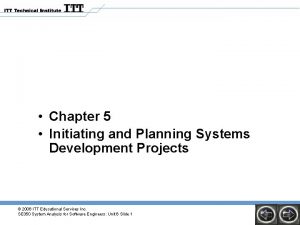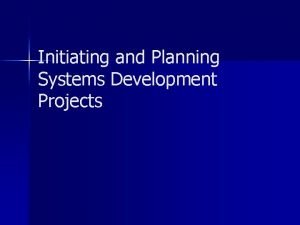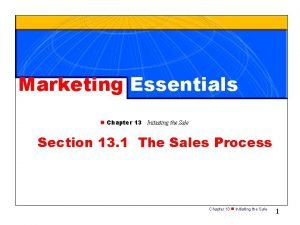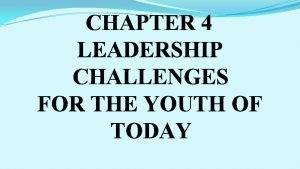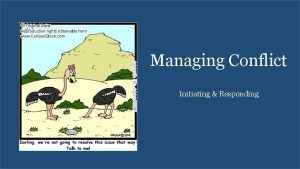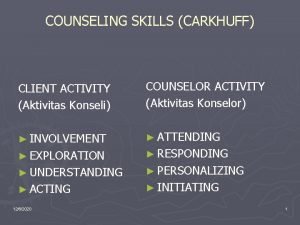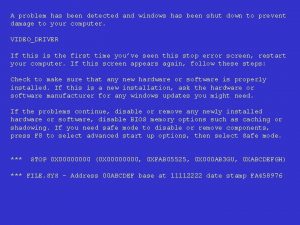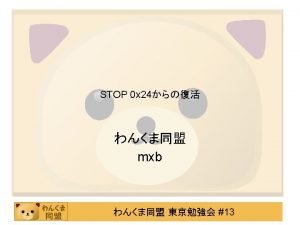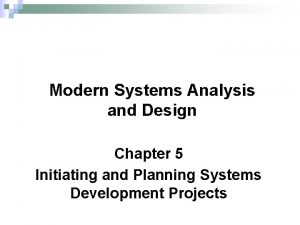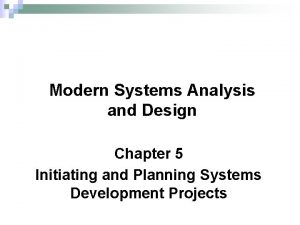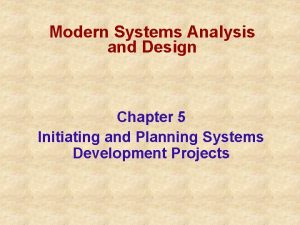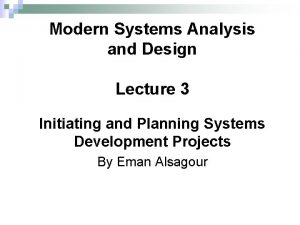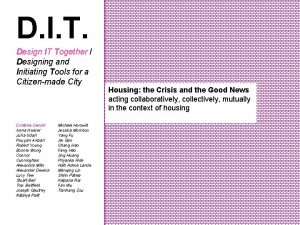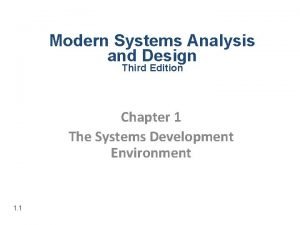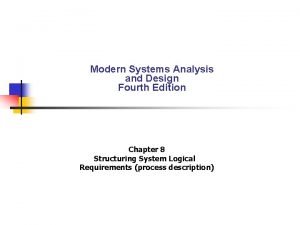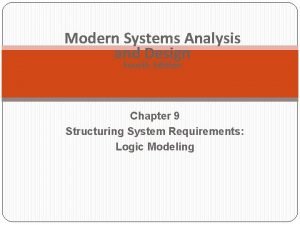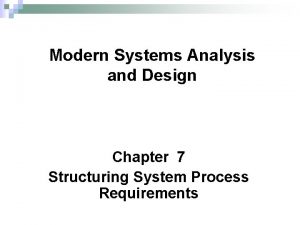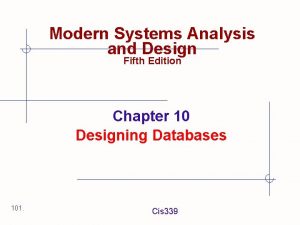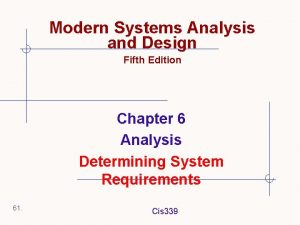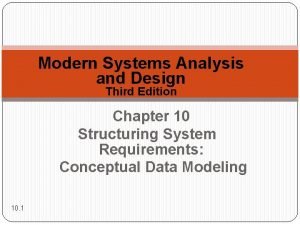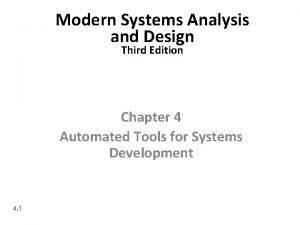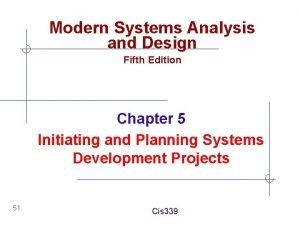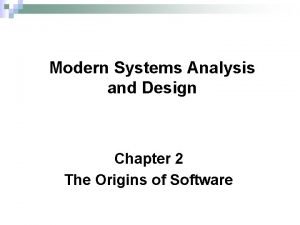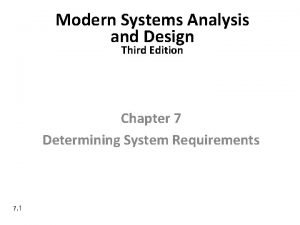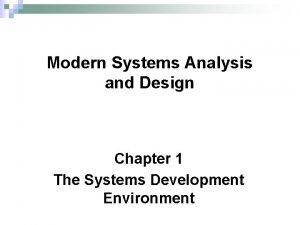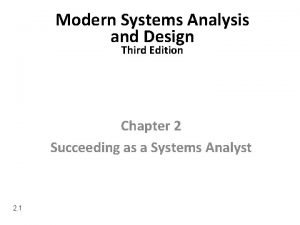Modern Systems Analysis and Design Chapter 5 Initiating

































- Slides: 33

Modern Systems Analysis and Design Chapter 5 Initiating and Planning Systems Development Projects

The Process of Initiating and Planning IS Development Projects n The key activity of project initiation is the development of the project charter. ¨A short document that is prepared for both internal and external stakeholders ¨ Provides a high-level overview of the project ¨ Useful communication tool that helps to assure that the organizations and other stakeholders understand the initiation of a project Chapter 5 Copyright © 2011 Pearson Education, Inc. Publishing as Prentice Hall 2

The Process of Initiating and Planning IS Development Projects (Cont. ) The key activity of project planning is the process of defining clear, discrete activities and the work needed to complete each activity within a single project. n The objective of the project planning process is the development of a Baseline Project Plan (BPP) and the Project Scope Statement (PSS). n Chapter 5 Copyright © 2011 Pearson Education, Inc. Publishing as Prentice Hall 3

Deliverables and Outcomes n Business Case ¨ Justification for an information system ¨ Presented in terms of the tangible and intangible economic benefits and costs ¨ The technical and organizational feasibility of the proposed system Chapter 5 Copyright © 2011 Pearson Education, Inc. Publishing as Prentice Hall 4

Deliverables and Outcomes (Cont. ) n Baseline Project Plan (BPP) ¨A major outcome and deliverable from the PIP phase ¨ Contains the best estimate of a project’s scope, benefits, costs, risks, and resource requirements Chapter 5 Copyright © 2011 Pearson Education, Inc. Publishing as Prentice Hall 5

Deliverables and Outcomes (Cont. ) n Project Scope Statement (PSS) ¨A document prepared for the customer ¨ Describes what the project will deliver ¨ Outlines at a high level all work required to complete the project Chapter 5 Copyright © 2011 Pearson Education, Inc. Publishing as Prentice Hall 6

Assessing Project Feasibility Economic n Technical n Operational n Scheduling n Legal and contractual n Political n Chapter 5 Copyright © 2011 Pearson Education, Inc. Publishing as Prentice Hall 7

Assessing Project Feasibility (Cont. ) n Economic feasibility: a process of identifying the financial benefits and costs associated with a development project ¨ Often referred to as a cost-benefit analysis ¨ Project is reviewed after each SDLC phase in order to decide whether to continue, redirect, or kill a project Chapter 5 Copyright © 2011 Pearson Education, Inc. Publishing as Prentice Hall 8

Determining Project Benefits Tangible benefits refer to items that can be measured in dollars and with certainty. n Examples include: n ¨ reduced personnel expenses, ¨ lower transaction costs, or ¨ higher profit margins. Chapter 5 Copyright © 2011 Pearson Education, Inc. Publishing as Prentice Hall 9

Determining Project Benefits (Cont. ) n Most tangible benefits will fit within the following categories: ¨ Cost reduction and avoidance ¨ Error reduction ¨ Increased flexibility ¨ Increased speed of activity ¨ Improvement of management planning and control ¨ Opening new markets and increasing sales opportunities Chapter 5 Copyright © 2011 Pearson Education, Inc. Publishing as Prentice Hall 10

Determining Project Benefits (Cont. ) n Intangible benefits are benefits derived from the creation of an information system that cannot be easily measured in dollars or with certainty. ¨ May have direct organizational benefits, such as the improvement of employee morale. ¨ May have broader societal implications, such as the reduction of waste creation or resource consumption. Chapter 5 Copyright © 2011 Pearson Education, Inc. Publishing as Prentice Hall 11

Determining Project Costs Tangible cost: a cost associated with an information system that can be measured in dollars and with certainty n IS development tangible costs include: n ¨ Hardware costs, ¨ Labor costs, or ¨ Operational costs including employee training and building renovations. Chapter 5 Copyright © 2011 Pearson Education, Inc. Publishing as Prentice Hall 12

Determining Project Costs (Cont. ) Intangible cost: a cost associated with an information system that cannot be easily measured in terms of dollars or with certainty n Intangible costs can include: n ¨ Loss of customer goodwill, ¨ Employee morale, or ¨ Operational inefficiency. Chapter 5 Copyright © 2011 Pearson Education, Inc. Publishing as Prentice Hall 13

Determining Project Costs (Cont. ) n n One-time cost: a cost associated with project start-up and development or system start-up These costs encompass activities such as: ¨ Systems development, ¨ New hardware and software purchases, ¨ User training, ¨ Site preparation, and ¨ Data or system conversion. Chapter 5 Copyright © 2011 Pearson Education, Inc. Publishing as Prentice Hall 14

Determining Project Costs (Cont. ) n n Recurring cost: a cost resulting from the ongoing evolution and use of a system Examples of these costs include: ¨ Application software maintenance, ¨ Incremental data storage expenses, ¨ Incremental communications, ¨ New software and hardware leases, and ¨ Supplies and other expenses (i. e. paper, forms, data center personnel). Chapter 5 Copyright © 2011 Pearson Education, Inc. Publishing as Prentice Hall 15

Determining Project Costs (Cont. ) Both one-time and recurring costs can consist of items that are fixed or variable in nature. n Fixed costs are billed or incurred at a regular interval and usually at a fixed rate. n Variable costs are items that vary in relation to usage. n Chapter 5 Copyright © 2011 Pearson Education, Inc. Publishing as Prentice Hall 16

Determining Project Costs (Cont. ) n Procurement ¨ Consulting, equipment, site preparation, capital, management time n Start-up ¨ Operating systems, communications installation, personnel hiring, organizational disruption n Project-related ¨ Application software, software modification, personnel overhead, training, data analysis, documentation n Operating ¨ System maintenance, rental, asset depreciation, operation and planning Chapter 5 Copyright © 2011 Pearson Education, Inc. Publishing as Prentice Hall 17

The Time Value of Money n Net Present Value (NPV) ¨ Use discount rate to determine present value of cash outlays and receipts n Return on Investment (ROI) ¨ Ratio n of cash receipts to cash outlays Break-Even Analysis (BEA) ¨ Amount of time required for cumulative cash flow to equal initial and ongoing investment Chapter 5 Copyright © 2011 Pearson Education, Inc. Publishing as Prentice Hall 18

The Time Value of Money Time value of money (TVM): the concept that money available today is worth more than the same amount tomorrow n Discount rate: the rate of return used to compute the present value of future cash flows (the cost of capital) n Present value: the current value of a future cash flow n Chapter 5 Copyright © 2011 Pearson Education, Inc. Publishing as Prentice Hall 19

The Time Value of Money (Cont. ) n Net Present Value ¨ PVn = present value of Y dollars n years from now based on a discount rate of i. ¨ NPV = sum of PVs across years. ¨ Calculates time value of money Chapter 5 Copyright © 2011 Pearson Education, Inc. Publishing as Prentice Hall 20

The Time Value of Money (Cont. ) n Break-even analysis: a type of costbenefit analysis to identify at what point (if ever) benefits equal costs Chapter 5 Copyright © 2011 Pearson Education, Inc. Publishing as Prentice Hall 21

10/23/2021 Chapter 5 Copyright © 2011 Pearson Education, Inc. Publishing as Prentice Hall 22

10/23/2021 Chapter 5 Copyright © 2011 Pearson Education, Inc. Publishing as Prentice Hall 23

Cost Terms n n n Total Cost of Ownership (TCO): The total cost of acquiring, installing, maintaining, changing, and getting rid of something across an extended period of time TCO is a life cycle estimate TCO supports decision making when it is likely that all options come with the same benefits and the only differences are on the cost side. TCO analysis shows what an acquisition implies for future spending or budgetary planning Five year TCO for computing equipment can be 3 – 10 times the original purchase price The Gartner Group* reports that nearly 80% of total IT costs occur after purchase and nearly half of these costs are outside the IT budget *Gartner is an information technology research and advisory company providing technology related insight. Research provided by Gartner is targeted at CIOs and senior IT leaders in industry 24

Total Cost of Ownership Cost Components Hardware acquisition Purchase price of hardware including computers, terminals, storage and printers Software acquisition Purchase or license of software for each user Installation Cost to install hardware and software Training Cost to train IT staff and end-users Support Cost to provide ongoing technical support; help desks, documentation etc Infrastructure Cost to acquire, maintain and support related infrastructure such as networks and specialized equipment (including storage and backup units) Downtime Lost productivity if hardware or software failures cause the system to unavailable for processing user tasks Space and energy Real estate and utility costs for hosing and providing power for the technology

Cost Terms (cont’d) n n n 26 Cost Item: A spending category for something the company spends money on, including assets, goods, services, and resources of all kinds ¨ Examples: Staff salaries, security service fees, the purchase of computer hardware or software Cost items are line items in budgets and spending plans Most business cases have many cost items and just a few benefit items Typically 80% or more of business case development goes into finding cost items, identifying cost impacts, and measuring and valuing them Cash Flow: Cash that actually flows into or out of the company

Overview of the Cost Model Organizes the cost items that belong in the case by category The cost model for a business case dealing with an IT system proposal. Each cell holds cost line items. 27

Line Items for the IT Cost Model Use this model as a guide and for a“brainstorming” workshop with the project team The same cost model should be applied to all scenarios in the case 28

Assessing Technical Feasibility n Technical feasibility: a process of assessing the development organization’s ability to construct a proposed system Chapter 5 Copyright © 2011 Pearson Education, Inc. Publishing as Prentice Hall 29

Assessing Other Feasibility Concerns n Operational ¨ Does the proposed system solve problems or take advantage of opportunities? n Scheduling ¨ Can the project time frame and completion dates meet organizational deadlines? n Legal and Contractual ¨ What are legal and contractual ramifications of the proposed system development project? n Political ¨ How do key stakeholders view the proposed system? Chapter 5 Copyright © 2011 Pearson Education, Inc. Publishing as Prentice Hall 30

Factors in Determining Scope Organizational units affected by new system n Current systems that will interact with or change because of new system n People who are affected by new system n Range of potential system capabilities n Constraints on system n Chapter 5 Copyright © 2011 Pearson Education, Inc. Publishing as Prentice Hall 31

Diagram Depiction of Project Scope More on this later De. Marco notation FIGURE 5 -11 Context-level data flow diagram showing project scope for Purchasing Fulfillment System Chapter 5 Copyright © 2011 Pearson Education, Inc. Publishing as Prentice Hall 32

Reviewing the Baseline Project Plan n n Structured Walkthroughs: a peer-group review of any product created during the system development process Can be applied to BPP, system specifications, logical and physical designs, program code, test procedures, manuals and documentation Chapter 5 Copyright © 2011 Pearson Education, Inc. Publishing as Prentice Hall 33
 Initiating and planning systems development projects
Initiating and planning systems development projects Initiating and planning systems development projects
Initiating and planning systems development projects Modern systems analysis and design
Modern systems analysis and design Systems analysis and design 5th edition
Systems analysis and design 5th edition A modern approach to systems analysis and design
A modern approach to systems analysis and design Modern systems analysis and design 7th edition
Modern systems analysis and design 7th edition Merchandise approach method
Merchandise approach method Initiating camaraderie and smooth relationship
Initiating camaraderie and smooth relationship Bcf model conflict resolution
Bcf model conflict resolution Requirement validation in software engineering
Requirement validation in software engineering Differentiating stage
Differentiating stage Attending responding personalizing initiating
Attending responding personalizing initiating Initiating process group
Initiating process group A problem has been
A problem has been The problem has been detected and windows shutdown
The problem has been detected and windows shutdown Kendall kendall
Kendall kendall Systems analysis & design in an age of options
Systems analysis & design in an age of options Gantt chart system analysis and design
Gantt chart system analysis and design Systems analysis and design in a changing world
Systems analysis and design in a changing world System analysis and design in a changing world
System analysis and design in a changing world Systems analysis and design alan dennis
Systems analysis and design alan dennis Sad system analysis and design
Sad system analysis and design Structured system analysis and design method
Structured system analysis and design method Kendall and kendall system analysis and design
Kendall and kendall system analysis and design Alan dennis system analysis design
Alan dennis system analysis design Systems analysis and design alan dennis
Systems analysis and design alan dennis Systems analysis and design alan dennis
Systems analysis and design alan dennis Systems analysis and design alan dennis
Systems analysis and design alan dennis Systems analysis and design alan dennis
Systems analysis and design alan dennis Systems analysis and design alan dennis
Systems analysis and design alan dennis Systems analysis and design alan dennis
Systems analysis and design alan dennis Ssadm diagram
Ssadm diagram Radar systems analysis and design using matlab
Radar systems analysis and design using matlab Object-oriented systems analysis and design using uml
Object-oriented systems analysis and design using uml
